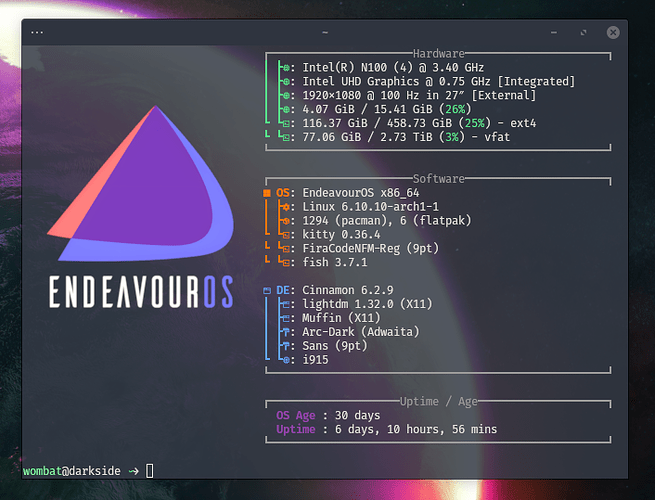Well, to run Fastfetch, you need a configuration file. Fastfetch’s is called config.jsonc. It is located in /home/USER/.config/fastfetch. If it’s not present, run fastfetch --gen-config.
Here’s mine. Right under logo, where it says source, I included a generic path to an image. Choose whatever image you like. My entry looks like this: "/home/wombat/Pictures/Linux/EndeavourOS/eos.png",. Your path will, of course, depend on where the image you want to use is. I’ve found that the best image size to use is between 300x300 and 500x500.
{
"$schema": "https://github.com/fastfetch-cli/fastfetch/raw/dev/doc/json_schema.json",
"logo": {
"source": "/PATH_TO_IMAGE/YOUR_IMAGE.png",
"type": "auto",
"height": 15,
"width": 30,
"padding": {
"top": 5,
"left": 3
}
},
"modules": [
"break",
{
"type": "custom",
"format": "\u001b[90m┌──────────────────────Hardware──────────────────────┐"
},
{
"type": "host",
"key": " PC",
"keyColor": "green"
},
{
"type": "cpu",
"key": "│ ├",
"showPeCoreCount": true,
"keyColor": "green"
},
{
"type": "gpu",
"key": "│ ├",
"keyColor": "green"
},
{
"type": "display",
"key": "│ ├",
"keyColor": "green"
},
{
"type": "memory",
"key": "│ ├",
"keyColor": "green"
},
{
"type": "disk",
"key": "└ └",
"keyColor": "green"
},
{
"type": "custom",
"format": "\u001b[90m└────────────────────────────────────────────────────┘"
},
"break",
{
"type": "custom",
"format": "\u001b[90m┌──────────────────────Software──────────────────────┐"
},
{
"type": "os",
"key": " OS",
"keyColor": "yellow"
},
{
"type": "kernel",
"key": "│ ├",
"keyColor": "yellow"
},
{
"type": "packages",
"key": "│ ├",
"keyColor": "yellow"
},
{
"type": "terminal",
"key": "└ └",
"keyColor": "yellow"
},
{
"type": "terminalfont",
"key": "└ └",
"keyColor": "yellow"
},
{
"type": "shell",
"key": "└ └",
"keyColor": "yellow"
},
"break",
{
"type": "de",
"key": " DE",
"keyColor": "blue"
},
{
"type": "lm",
"key": "│ ├",
"keyColor": "blue"
},
{
"type": "wm",
"key": "│ ├",
"keyColor": "blue"
},
{
"type": "wmtheme",
"key": "│ ├",
"keyColor": "blue"
},
{
"type": "font",
"key": "│ ├",
"format": "{3}",
"keyColor": "blue"
},
{
"type": "gpu",
"key": "└ └",
"format": "{3}",
"keyColor": "blue"
},
{
"type": "custom",
"format": "\u001b[90m└────────────────────────────────────────────────────┘"
},
"break",
{
"type": "custom",
"format": "\u001b[90m┌────────────────────Uptime / Age────────────────────┐"
},
{
"type": "command",
"key": " OS Age ",
"keyColor": "magenta",
"text": "birth_install=$(stat -c %W /); current=$(date +%s); time_progression=$((current - birth_install)); days_difference=$((time_progression / 86400)); echo $days_difference days"
},
{
"type": "uptime",
"key": " Uptime ",
"keyColor": "magenta"
},
{
"type": "custom",
"format": "\u001b[90m└────────────────────────────────────────────────────┘"
},
"break",
]
}
Using that config (along with my personal image path) provides this…
